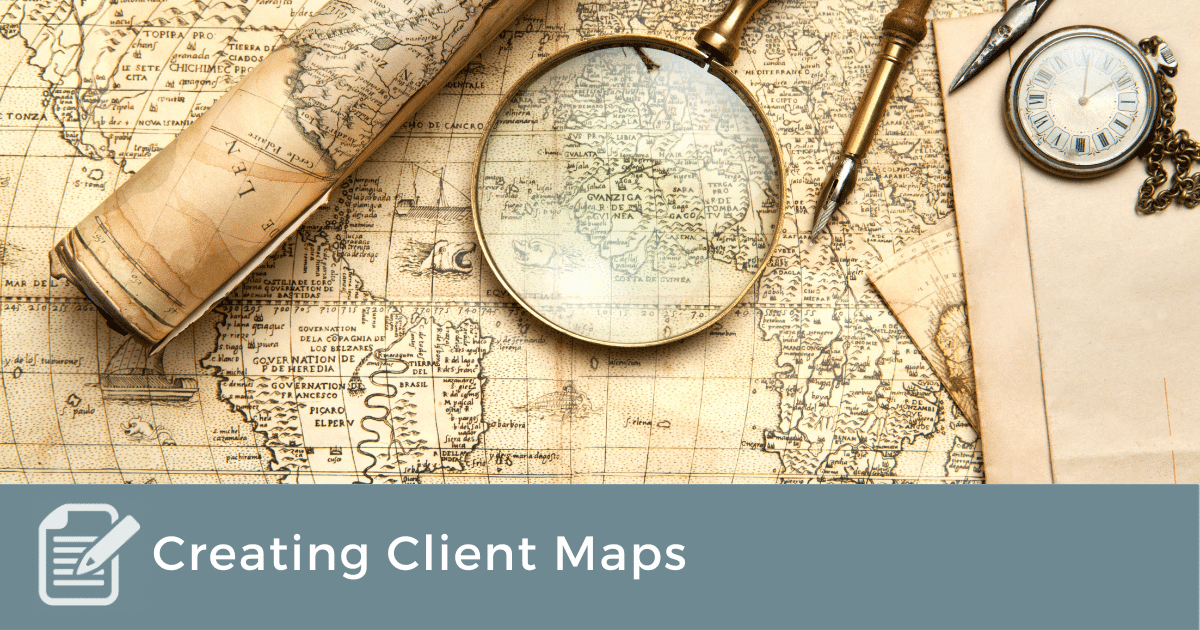
On our honeymoon, Danelle and I were traveling southeast through southern Indiana on our way to the Smoky Mountains when the road suddenly ended. Looking ahead, the blacktop petered out and an enormous pile of rock lay right in the middle of the road. At least, it would have, had there been a road. We had chosen this route based on a map of Indiana, which showed this to be the shortest and fastest route.
We stopped at a nearby gas station and inquired about the situation: “What happened to the road?” The answer was simple, it wasn’t finished yet. This was 1991, pre-GPS, pre-Google Maps. The map we purchased of southern Indiana had put this new road on their map even though it wasn’t quite finished. Maps did not automatically update in those days.
It got worse. Our next question was “How do we get to Louisville from here?”
“Louisville? You can’t get there from here.” Your client may hear that same voice in their head.
In truth, we could, but we had to take the windiest, hilliest roads we had ever seen. By the time we got to our hotel, we were seasick from the journey. Our map failed us on one of the most important days of our lives. Your client will be experiencing some form of nausea as well.
Even though our map failed us that day, we never would have made it to our destination without one. Maps have made safe, long-distance movement possible. Quoting cartography expert Kirk Goldsberry, Brene Brown writes:
“Maps are the most important documents in human history. They give us tools to store and exchange knowledge about space and place.” — Atlas of the Heart
In the simplest terms, coaching is about helping people get from where they are to where they want to go, hence our coaching mantra, “We help them draw a map.” Dr. Goldsberry shared with Brown that maps “have layers, have labels, and make meaning.” These three elements can help our clients map out their situations.
Maps Have Layers
At a family gathering, my ten-year-old niece, Lily, was showing me where she lived on Google Maps. An added layer to this map showed a photograph of her house. Then, she showed me something I had never seen before, a new layer that revealed what her neighborhood looked like ten years ago. A few houses changed color. A few trees appeared in the landscape that no longer existed.
Layering is another way to add dimension to people’s thinking. To a geographical map, we could add layers that show nearby restaurants, average rainfall, underground sewer tunnels, traffic patterns, mean dogs, average family income… The number of additional layers might be endless. This means that when you’re helping a client map their situation, there are all kinds of layers you could help them consider.
I have a client who has a time management problem. He has a main job, a side job, family commitments, and not enough time to accomplish all three to his satisfaction. By thinking of each element as a layer, the client can prioritize which element gets precedence. Perhaps the client finds only having three layers too clumsy. He may need to subdivide each layer into multiple layers; for example, he might create a separate layer for time with his wife.
Adding layers to a map evokes much awareness about priority.
Maps Have Labels
I was searching a neighborhood for 4024 Lincoln Street. Driving up and down Lincoln, I followed the numbering up to 4016, but then the numbers jumped to 4032. There was no 4024 to be found. I looked for a cul de sac. I looked on the other side of the street, just in case. The business I was looking for simply did not exist! That is, until I realized I was on Lincoln Avenue and not Lincoln Street. Sure enough, once I got on the right road, 4024 was right where it was supposed to be.
According to Dr. Goldberry, author of Sprawlball: A Visual Tour Era of the New NBA, “50 to 60 percent of the challenge of mapmaking is labeling the map in a way that appropriately prioritizes the right information.” Coaching should ensure the client labels their map correctly. This often requires new awareness.
Going back to my previous example, my client could add a number of labels to his map. Hours required, energy required, personal satisfaction, future return, etc. By adding the label “energy required,” the client begins to see an interesting separation in the data. Future return is a label that may help him communicate his decision to family members who become frustrated with his choices.
As the labels improve, the client will gain new awareness surrounding the issue at hand. This new awareness will help the client understand the meaning that their map has communicated.
Maps Make Meaning
A cemetery is a living (or actually, dead) map full of layers and labels. Together, they communicate meaning. One person was born and died in the same year. These people all died in the same month during a pandemic. Some cemeteries carry a sacred feel, which is all about meaning. A great map communicates, and sometimes even creates, meaning.
Many times, when making a map with our clients, they will realize that the situation they’re dealing with is not random but might in fact be quite predictable. They might realize that what they thought was the source of the issue is not the source at all. A map may show how a different route could completely change the outcome. Maps make the data meaningful.
Revisiting my client’s issue a final time, he may find that time with family is more important than he first considered, or he may find that this side job is where he’d like to invest most of his time in order to create something for the future. Alternatively, he may find an innovative way to use less energy in his main job.
When something becomes meaningful, it becomes useful—it becomes applicable. Meaning makes the situation much more navigable.
Conclusion: Maps are Essential to Orientation.
There are two ways to make a map: one is based on your own experience, and the other is with other travelers’ data. As a coach, we must remember that we are using our client’s data. We must set our own experience aside as best we can and instead focus on the meta aspects of map making, adding layers, creating labels, and exposing meaning.
Maps are truly the most important documents in history. As coaches, we are essentially map makers and add tremendous value to our clients by helping them create helpful maps of their situations in order to orient themselves in their lives.


